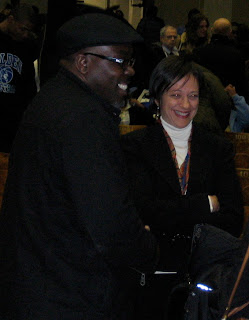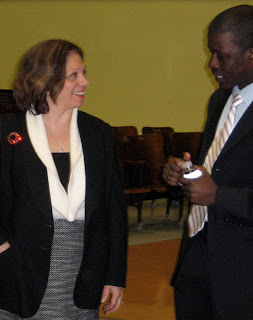
by Norman Scott
They say traveling to far away places can be broadening. But sometimes the longest journeys are not measured in miles.
An invitation to attend a luncheon sponsored by the Manhattan Institute for Policy Research required preparations worthy of a trip to the Himalayas.
Generally perceived as being right wing supporters of privatization efforts and often leading the attacks on public schools and teacher unions, their mission statement is “to develop and disseminate new ideas that foster greater economic choice and individual responsibility.” The lead quote on their web site is by Rudy Giuliani. Better get the full battery of shots.
The luncheon featured Christopher Cerf, the Deputy Chancellor for Organizational Strategy, Human Capital, and External Affairs for the NYC Department of Education. That mouthful of a job description tells you a lot. As an educational writer I have criticized and satirized Cerf, the former CEO of Edison Schools, a for-profit company that milks money from the public schools. Cerf has been featured recently in the press for all kinds of fun things, like trying to hide not selling his stock in Edison and only doing so surreptitiously when it became clear this fact would be revealed. I had published a photo on my blog of Cerf seeming to be dozing at one of Joel Klein’s press conferences. Klein is his boss. I better bring a food taster.
The luncheon was being held at the University Club on 5th Ave. and 54th St. Always prepare for journeys by reading your travel guide. Mine said:
“Designed by Stanford White this is the city's grandest clubhouse. With its deep rustication, grand proportions and superb craftsmanship, it is the city's finest Italian Renaissance palazzo-style structure. As impressive as its exterior, the interior of the building is splendiferous with rich marbles, gilded columns, fine woods and excellent murals by H. Siddons Mowbray. The three most impressive rooms are the reading lounge on the elevated first floor overlooking Fifth Avenue, the magnificent third-floor double-height dining room that stretches the length of the building's side street frontage, and the enormous, vaulted library. In 1987 the club admitted women.”
Hey! Change takes time in far away places. I better get a 2nd set of shots.
I dressed carefully. Digging out my best and darkest corduroy jacket, I desperately searched for a pair of matching corduroy pants that would give the rough impression I was wearing a suit. I found something. It was black. Sort of. I put on a black button down shirt worn over a black tee-shirt with white lettering that said “Quantum Samurai Scorpions” given to me by the robotics team at Aviation high school. In case of violence, I would rip off my jacket and shirt and use the scorpion on my shirt to back them away. But I would be helpless if they resorted to blowguns that shot voucher darts. I added black sneakers disguised as shoes for quick getaway and I was ready to go.
On my way down the street, my feet began to slip on the ice from the storm the day before. Back to the house to change into my tan-with black-border waterproof hiking boots that I had bought for last year’s trip to Costa Rica but hadn’t worn since. I could kick my way out of there if attacked. My outfit complete, I was off to the B train with a change for the V at 47rd St. I practiced my moves in the subway.
I approached the University Club with stealth, searching for a way in. I used my passport to get past the outer-borough-denizen filtering system. Then past the next six doormen — after a brain scan designed to seek out alien thoughts — like any inclination to oppose the conversion of every public school in Manhattan into condos.
I approached the next barrier, a man in a red jacket whose first words were, “You need a jacket and tie,” looking at me like I had just been scraped off his shoe. I opened my coat and said, “I have the jacket. One out of 2 ain’t bad.” He didn’t smile. “The invitation didn’t say anything about a tie,” I whined. “We have ties in the back,” he said, looking down at my hiking boots.
I was going to ask him where I could change money since I heard they used a currency I was not familiar with — millions. I’m pretty much a ten and twenty man. I thought better of it.
I went to the cloakroom to check my dark, down coat, which left feathers clinging to my corduroy. I tried to cover up the ketchup stains still lingering from last night’s fries. The guys at the checkroom sent me to the back to pick out a tie from a rack of rejects. I chose a lovely school tie – blue field with yellow markings, some of which looked to be moving. I made the tie in the mirror in the lobby while sneering people passed me by. Finally, I was ready for combat.
The Manhattan Institute luncheon was on the 7th floor, not one of the three grand rooms, but c’est la vie — maybe next time. I got off the elevator and approached the lady at the entry desk sitting with a pile of nametags in front of her. I expected mine wouldn’t be there, sure the people from the Department of Education, who’ve have been tracking my every move, would try to keep me away. But there it was. It had a safety pin on the back. I looked around to see where other people attached their tags so I wouldn’t make myself stand out by having a nametag out of place. For a moment, I thought of showing my defiance by putting it where it was guaranteed to get noticed. Not a good idea. Damn safety pins.
I entered the room. Lots of wood and twenty-foot ceilings with painted angels hovering over clouds, looking down with looks on their faces like they had to pee. I was one of the first ones there even though it was 12 o’clock. I forgot to be fashionably late. There was a table with drinks. Wine. A glass of red would calm me down and then I could stand in the corner and observe the species, getting in touch with my own Jane Goodall. Mingling was not going to be happening for me today.
The lady in front of me asked the server what the white wine was. “Chardonnay” was the response. She snorted and said, “I’ll take red.” “Red for me too,” I echoed. She turned and smiled. I said, “I really want Merlot but am afraid to ask since that wine movie trashed the Merlots.” “I like Merlot too,” she laughed. We spoke about wine and schools for the next ten minutes. Turned out she was also a fugitive from NYC schools, but had risen considerably higher than I, becoming one of the rulers and shakers before she retired to become CEO of a company setting up charter schools nationwide. We exchanged contact info and I was off to my corner to listen and observe. I heard lots of breathless, “We’re just waiting for the charter schools cap to be lifted.” The public Ed gravy train will be long indeed.
I become a mingler after a glass of wine on an empty stomach takes effect. I floated around looking at nametags. There was the former CEO of one of the major financial firms in the world. Dismantling public schools is hot with the corporate types — they can say they served humanity. I saw two reporters I knew. Someone tapped me on the shoulder. “Norm, good to meet you. I feel like an alien.” It was JB. We knew each other from a common listserve we are on but it was the first time we had met. There were other aliens whose names I recognized. It turned out there were more people there for the free lunch than I imagined. We banded together like Custard’s army at the Little Big Horn.
Finally, we were called to lunch. Chicken and dessert. And a roll. Not top shelf. The wine had gone to my head. I sat at a corner table with someone I knew from years before. Cerf made his outrageous presentation to much clucking from the audience. I disagreed with 99% of it. When the question period came, I raised my hand in vain. Just as I was about to rip off my jacket and shirt and start using Quantum Samarai moves, I got called on for the last question of the day. Needless to say, there won’t be a next time.
This article was originally written as a travel piece for the LostWriters web site and can be accessed at: http://www.lostwriters.net. It also appeared in print in The Wave on Feb. 23, 2007.
















